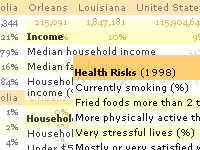![]()
Home ![]() Pre Katrina Home
Pre Katrina Home ![]() Articles
Articles ![]() What data do funders want to see?
What data do funders want to see?
 What data do funders want to see in Problem Statements?
What data do funders want to see in Problem Statements?
Quick tips on what types of numbers are helpful and not helpful for funders when they're assessing how much need there is for the program you're proposing.
![]()
by Allison Plyer |
needs |
Feb. 27, 2002 | We often hear that funders want to see data in needs assessments of grant proposals. But what data exactly do funders want to see? Well, they want to see data that helps them to decide where they should invest their resources. But that doesn’t tell us much, does it?
So, what kind of data is helpful to funders in making those decisions? Data that gives them the big picture of where and how big the problems are. Of course, some data is more helpful in seeing the big picture than other data.
Tips on what types of data to include
Below are some tips on the kinds of data funders find helpful and the kinds of data they find not helpful. A quick way to critique the usefulness of the data you’ve been putting in your problem statements is to scan down the “not helpful” column and see if you’ve ever used data that’s not helpful. (A lot of people do, so don’t be embarrassed.) If you see a type of data that you’ve used that’s not helpful, you’ll see next to it a helpful alternative. Reviewing this list should put you on the path to giving funders the data they really want in problem statements.
 NOT helpful NOT helpful |
|
|
Data about the number of people you serve, the number of people who are on your waiting list, the number of activities you conduct each year. |
vs | Data from external sources that point to the size of the problem in the community where you are proposing to work. In what cases might 'number of clients' be good data to include? |
Data that represents geographic areas larger than the area you are targeting (like cancer rates for the whole state of Louisiana when you are only going to be doing cancer screenings in the housing developments in Orleans Parish). |
vs | Data that represents the specific neighborhood(s) where you are working.
|
| Raw numbers that describe the problem in your area. | vs | Raw numbers AND percentages that show the proportion of the total population in your area that is affected by the problem. |
Only numbers that represent the geographic area where you work without any comparison data. |
vs | Comparison data from the national level and other geographic levels of interest to the funder. |
Data that is not relevant to the problem (like high school drop out rates when you are going to be providing pre school educational development services). |
vs | Data that scientific research has demonstrated is related to the problem you are addressing (like data about pregnancy-related deaths when you are going to be providing prenatal care). |
Data from newspapers, magazines, and TV news programs – sources that are not in the business of distributing reliable data. (Newspapers, for example, are in the business of selling newspapers, of course.) |
vs | Data from reputable sources such as government agencies, national associations, and peer-reviewed journals. |
Data that are old (like 1990 Census data on race). |
vs | The most recent available data from the chosen data source (like 2000 Census data on race). |
| All the data you’ve ever found that relates somewhat to the problem. We call this a “data dump.” | vs | Data carefully selected and narrowed down from the entire list of all the data you found and presented in a targeted, compelling, concise problem statement. |
If you follow the above tips, you will include data in your problem statement that funders will find very helpful. Remember that these tips apply only to needs assessments. Other parts of the grant proposal may require different types of data.
Home ![]() Pre Katrina Home
Pre Katrina Home ![]() Articles
Articles ![]() What data do funders want to see?
What data do funders want to see?
![]()
Greater New Orleans Community Data Center Last modified: October 2, 2002 |
 Helpful
Helpful To learn more, read the article
To learn more, read the article